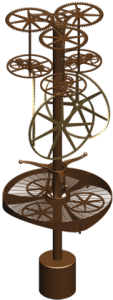On Wednesday, September 10th, the internet experienced a collective moment of action. As part of a protest called “Internet Slowdown Day,” websites as popular as Tumblr, Vimeo, The Onion, Metafilter, and Netflix raised alarm bells about a phenomenon that could erode free and open access to the internet: the death of net neutrality.
Net Neutrality, as the blog TechDirt succinctly explains, refers to “the concept of the end-to-end principle of the internet, in that anyone online could request a webpage or information from any online service, and the internet access provider (usually called internet service providers or ISPs) in the middle would deliver that information.” The idea is, no matter what website you visit, large or small, legal or illegal, tasteful or tasteless, your ISP will deliver it with the same speed and priority as any other site.
In recent years, this principle has become controversial. Several major cable providers have expressed their desire to restrict top-speed connections to websites that pay them a premium. Effectively, this would mean that large companies like Netflix and Google would be able to pay for their sites to be included in a “fast lane”, while websites owned by individuals, small businesses, and public institutions would be relegated to a “slow lane,” and would take much longer to load. According to John Oliver (in the video featured below), if this new policy were implemented, the fast lane wouldn’t get faster. It would stay the same speed while all other sites became slower.
Indeed, some say that dealings of this nature have already happened. In February, the Wall Street Journal reported that Netflix signed a deal with Comcast. The deal stated that Netflix would pay Comcast to improve the speed with which Comcast’s users would be able to access their streaming service. Two months later, Netflix signed a similar deal with Verizon. Afterwards, Netflix spoke out against the deals, claiming they were made under duress and calling for the FCC to impose stronger net neutrality regulations. According to Netflix, Comcast and Verizon were intentionally throttling users’ access to Netflix Streaming and would only allow full access if Netflix paid a toll.

Meanwhile, the FCC has been having a difficult time reigning in the cable companies. Multiple times, the FCC’s rules on net neutrality have been challenged and overturned in court. In 2010, the FCC challenged Comcast in court for selectively restricting Bittorrent traffic. The D.C. Circuit ruled in favor of Comcast, limiting the FCC’s ability to enforce net neutrality. Shortly after, the FCC rewrote their rules on Net Neutrality and issued the Open Internet Order to reassert their authority. However, in 2013 Verizon challenged these new rules in court and in 2014 they succeeded. The FCC is currently drafting up a new proposal to enforce net neutrality. Now, all eyes are on them, as the cable companies, the media, and members of the public speak out in favor of one side or the other.
Librarians should take note: even the American Library Association has taken a public stance on this issue. They’ve come out solidly in favor of net neutrality and against efforts by ISPs to circumvent it:
A world in which librarians and other noncommercial enterprises are of necessity limited to the Internet’s “slow lanes” while high-definition movies can obtain preferential treatment seems to us to be overlooking a central priority for a democratic society – the necessity of enabling educators, librarians, and, in fact, all citizens to inform themselves and each other just as much as the major commercial and media interests can inform them.
The entire statement is worth reading, as it strongly and succinctly details the issues at hand. They point out that higher education institutions and libraries being relegated to “slow lanes” would drastically impede distance learning. They also state that the diminishing of net neutrality would lead to market-distorting effects on the internet, reducing competition and innovation in internet services and content.
On July 18th of this year, the ALA and the ACRL filed joint comments with the FCC to advocate for stronger enforcement of net neutrality. In their comments they stated that the FCC should:
- explicitly apply open Internet rules to public broadband Internet access service provided to libraries, institutions of higher education and other public interest organizations;
- prohibit “paid prioritization;”
- adopt rules that are technology-neutral and apply equally to fixed and mobile services;
- adopt a re-defined “no-blocking” rule that bars public broadband Internet access providers from interfering with the consumer’s choice of content, applications, or services;
- further strengthen disclosure rules;
- charge the proposed ombudsman with protecting the interests of libraries and higher education institutions and other public interest organizations, in addition to consumers and small businesses;
- continue to recognize that libraries and institutions of higher education operate private networks or engage in end user activities not subject to open Internet rules; and
- preserve the unique capacities of the Internet as an open platform by exercising its well-established sources of authority to implement open Internet rules, based on Title II reclassification or an “Internet reasonable” standard under Section 706.
What can librarians and other information professionals do to support net neutrality? The ALA recommends that you:
- “Email to the ALA Washington Office (lclark[at]alawash[dot]org) examples of Internet Service Provider (ISP) slowdowns, lost quality of service relative to your subscribed ISP speeds, and any other harm related to serving your community needs. Alternately, please share examples of potential harm if we do not preserve the open internet (e.g., impact on cloud-based services and/or ability to disseminate digitized or streaming content on an equal footing with commercial content providers that otherwise might pay for faster “lanes” for their content over library content).”
- “Ask your board to support and/or adopt the network neutrality principles.”
- Submit a formal comment to the FCC’s website. The ALA has partnered with EDUCAUSE to prepare a template letter of support for net neutrality, available here. Today (the 15th) is the last day for formal comments, but the FCC will continue to accept “ex parte” comments until further notice. It is still useful to send your comments in, even after the formal window closes.
The FCC intends to create a new Order on net neutrality by the end of this year, and the efforts of librarians and information professionals could make a significant impact on their eventual decision. If net neutrality is important to you, now is the best time to speak out!
P.S. A large part of the recent public furor over net neutrality was sparked by this segment on the popular comedy news show “Last Week Tonight With John Oliver.” It’s surprisingly funny for such complex material. Be warned, there is a good deal of cursing.
(Post by Derek Murphy)

